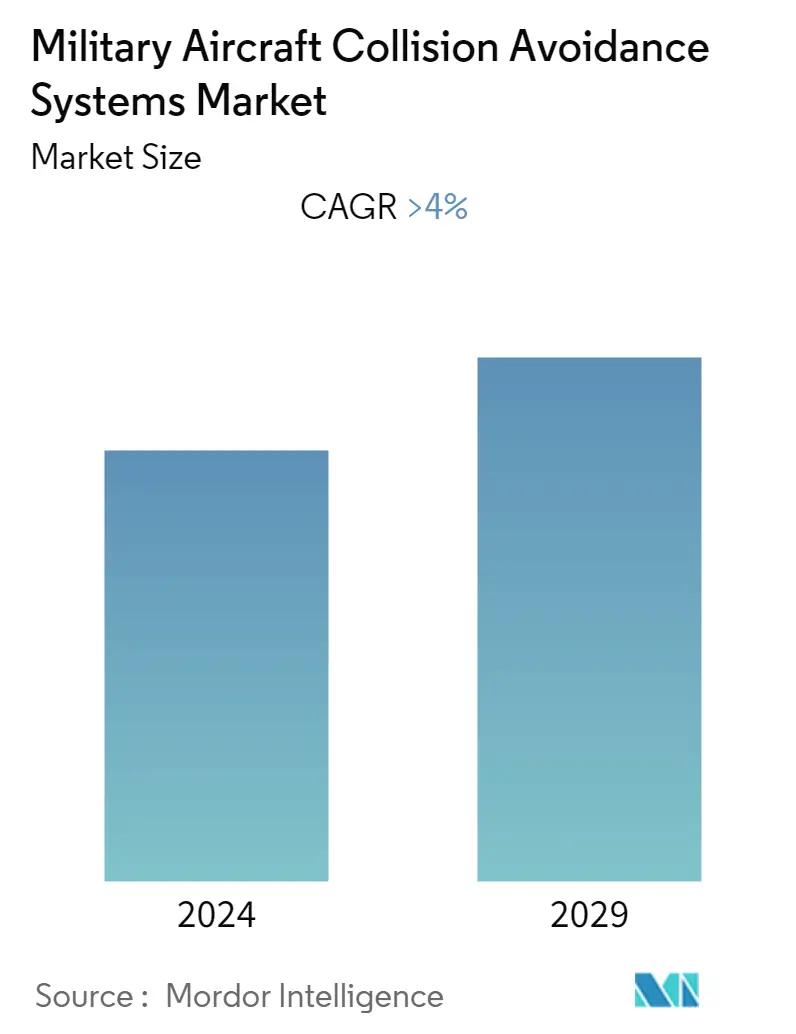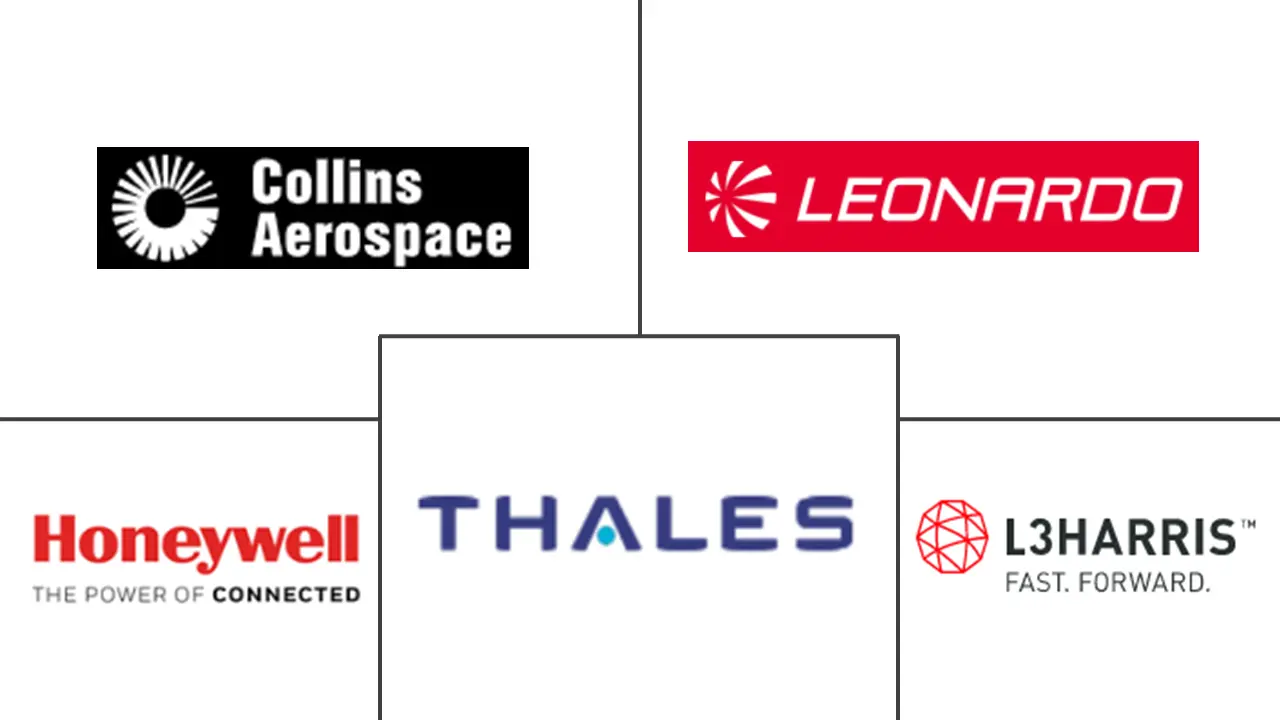Market Size of Military Aircraft Collision Avoidance Systems Industry

| Study Period | 2020 - 2029 |
| Base Year For Estimation | 2023 |
| CAGR | > 4.00 % |
| Fastest Growing Market | Asia-Pacific |
| Largest Market | North America |
| Market Concentration | High |
Major Players
*Disclaimer: Major Players sorted in no particular order |
Military ACAS Market Analysis
The military aircraft collision avoidance systems market is expected to grow at a CAGR of more than 4% during the forecast period.
The COVID-19 pandemic had a minor impact on the market. Although the production of military aircraft was slowed down for a brief period in 2020, the increase in military expenditure from all the countries has driven the demand for new military aircraft and has consequently driven the demand for military aircraft collision avoidance systems.
Increasing defense expenditure, rising military aircraft procurement contracts, and growing military modernization programs drive the growth of the market. An increasing focus on military aircraft safety is the major factor driving the market growth. Military aircraft operate in hazardous conditions, hence there are high chances of mid-air collisions and fatal accidents. Thus, military forces adopt sophisticated airborne collision avoidance systems, as the systems help to improve the operational safety of aircraft and pilots or troops.
Military forces across the world are using unmanned aerial vehicles (UAVs) for long-range missions. The collision avoidance systems in UAVs use onboard sensors to generate an image of the airspace surrounding the UAV. The sensor data is used to analyze various conflicts such as collisions, TCAS violations, and airspace violations. Since the implementation of collision avoidance systems is mandatory in UAVs, an increase in the adoption of UAVs may increase the demand for these systems, as they help to improve operational safety and enhance the lifetime of UAVs.
Military ACAS Industry Segmentation
Aircraft collision avoidance systems are designed to reduce the incidence of a mid-air collision between multiple aircraft and also between the aircraft and the terrain. The unmanned combat aerial vehicle market is segmented based on the system type, aircraft type, and geography. By system type, the market is segmented into radars, TCAS, TAWS, CWS, OCAS, and synthetic vision systems. By aircraft type, the market is segmented into manned aircraft and unmanned aircraft. The market sizing and forecasts have been provided in value (USD billion).
| System Type | |
| Radars | |
| TCAS | |
| TAWS | |
| CWS | |
| OCAS | |
| Synthetic Vision Systems |
| Aircraft Type | |
| Manned Aircraft | |
| Unmanned Aircraft |
| Geography | |||||||
| |||||||
| |||||||
| |||||||
| |||||||
|
Military Aircraft Collision Avoidance Systems Market Size Summary
The military aircraft collision avoidance systems market is poised for significant growth, driven by increasing defense expenditures and a focus on enhancing military aircraft safety. The demand for these systems is bolstered by the rising procurement of military aircraft and the adoption of advanced technologies to prevent mid-air collisions, which are critical in hazardous operational environments. The market is further propelled by the growing use of unmanned aerial vehicles (UAVs), where collision avoidance systems are essential for ensuring operational safety and extending the lifespan of these aircraft. The integration of sophisticated sensor technologies in UAVs to detect and mitigate potential airspace conflicts is a key factor contributing to market expansion.
Regionally, the Asia Pacific is expected to experience the highest growth rate, fueled by substantial military spending in countries like China and India, driven by geopolitical tensions and security concerns. These nations are investing in advanced collision avoidance technologies to enhance military aviation safety. The market is characterized by a consolidated landscape with major players like Honeywell International Inc., L3Harris Technologies, Inc., and Raytheon Technologies Corporation leading the charge in developing next-generation systems. Strategic partnerships and collaborations with aviation authorities and military end-users are pivotal for these companies, as they strive to innovate and meet the evolving demands of military aircraft safety.
Military Aircraft Collision Avoidance Systems Market Size - Table of Contents
-
1. MARKET DYNAMICS
-
1.1 Market Overview
-
1.2 Market Drivers
-
1.3 Market Restraints
-
1.4 Porter's Five Forces Analysis
-
1.4.1 Threat of New Entrants
-
1.4.2 Bargaining Power of Buyers/Consumers
-
1.4.3 Bargaining Power of Suppliers
-
1.4.4 Threat of Substitute Products
-
1.4.5 Intensity of Competitive Rivalry
-
-
-
2. MARKET SEGMENTATION
-
2.1 System Type
-
2.1.1 Radars
-
2.1.2 TCAS
-
2.1.3 TAWS
-
2.1.4 CWS
-
2.1.5 OCAS
-
2.1.6 Synthetic Vision Systems
-
-
2.2 Aircraft Type
-
2.2.1 Manned Aircraft
-
2.2.2 Unmanned Aircraft
-
-
2.3 Geography
-
2.3.1 North America
-
2.3.1.1 United States
-
2.3.1.2 Canada
-
-
2.3.2 Europe
-
2.3.2.1 Germany
-
2.3.2.2 United Kingdom
-
2.3.2.3 France
-
2.3.2.4 Russia
-
2.3.2.5 Rest of Europe
-
-
2.3.3 Asia-Pacific
-
2.3.3.1 India
-
2.3.3.2 China
-
2.3.3.3 Japan
-
2.3.3.4 South Korea
-
2.3.3.5 Rest of Asia-Pacific
-
-
2.3.4 Latin America
-
2.3.4.1 Brazil
-
2.3.4.2 Rest of Latin America
-
-
2.3.5 Middle-East and Africa
-
2.3.5.1 United Arab Emirates
-
2.3.5.2 Saudi Arabia
-
2.3.5.3 Egypt
-
2.3.5.4 Rest of Middle-East and Africa
-
-
-
Military Aircraft Collision Avoidance Systems Market Size FAQs
What is the current Military Aircraft Collision Avoidance Systems Market size?
The Military Aircraft Collision Avoidance Systems Market is projected to register a CAGR of greater than 4% during the forecast period (2024-2029)
Who are the key players in Military Aircraft Collision Avoidance Systems Market?
Honeywell International Inc., L3Harris Technologies Inc, Leonardo SpA, Thales Group and Collins Aerospace (Raytheon Technologies Corporation) are the major companies operating in the Military Aircraft Collision Avoidance Systems Market.

